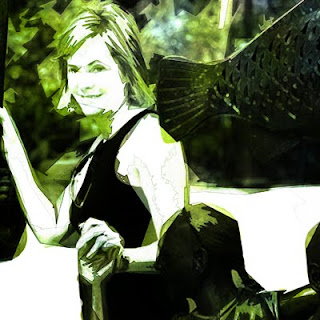 The afternoon sun casts its golden light onto the flat grassy field and the tall conifers surrounding it. It is the last of the warm rays, and the promise of a cool night dances at the park’s edge, ready to overtake the fiery warmth with a cold hand. But for the moment, darkness stays abated, and sweet light covers the park, making the tender grass alive with a yellow lens. On the warm greenery is a group of three young men with a bicycle laying upside-down beside them. Two of them look to the ground, to the open newspaper between them. The other man stares into the distance, at a young woman with a camera pointed in his direction. Not far from the group, a middle aged man sits cross-legged while filling a rolling paper with long strands of tobacco. In the far distance, a young man in a red sweatshirt stares at the screen on his cell phone.
The afternoon sun casts its golden light onto the flat grassy field and the tall conifers surrounding it. It is the last of the warm rays, and the promise of a cool night dances at the park’s edge, ready to overtake the fiery warmth with a cold hand. But for the moment, darkness stays abated, and sweet light covers the park, making the tender grass alive with a yellow lens. On the warm greenery is a group of three young men with a bicycle laying upside-down beside them. Two of them look to the ground, to the open newspaper between them. The other man stares into the distance, at a young woman with a camera pointed in his direction. Not far from the group, a middle aged man sits cross-legged while filling a rolling paper with long strands of tobacco. In the far distance, a young man in a red sweatshirt stares at the screen on his cell phone.The flat field is surrounded by a narrow black asphalt path, which, by its design, has created a large rounded-edge square of the grass. On the other side of the sidewalk is the mound of a small grassy hill. The hill is long, and its shape creates an amphitheater-like viewing of the flat field below. Two men lounge on the grass of the hill, they each lay on their side, just barely looking up at the man in cargo pants standing between them.
Between the men on the hill and the asphalt sidewalk is a long green bench. Its left side is occupied by a muscular black man who is as home on the bench as anywhere else. His beard is trim and completely white. The hair on his eyebrows and arms is also white. His chocolate-colored skin is smooth and taut. He wears a pair of clean blue jeans and a yellow fleece vest over a collared T-shirt. Above his plaid shirt is an ornate silver cross that is a few inches long. There is a black beanie on his head. Both his wrists are adorned with two metal bracelets of braided copper and silver. Beside the bench are his tan leather boots, the socks tucked neatly into the foot-holes. Draped casually over the back of the bench is his extra sweatshirt. Between his legs is a tall red drum. Well-worn hands are in mid beat as his eyes trail, watching the golden-tinged sights before him.



